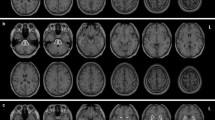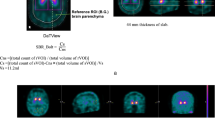Abstract.
The clinical differentiation between typical idiopathic Parkinson's disease (IPD) and atypical parkinsonian disorders such as multiple system atrophy (MSA) is complicated by the presence of signs and symptoms common to both forms. The goal of this study was to re-evaluate the contribution of brain perfusion single-photon emission tomography (SPET) with anatomical standardisation and automated analysis in the differentiation of IPD and MSA. This was achieved by discriminant analysis in comparison with a large set of age- and gender-matched healthy volunteers. Technetium-99m ethyl cysteinate dimer SPET was performed on 140 subjects: 81 IPD patients (age 62.6±10.2 years; disease duration 11.0±6.4 years; 50 males/31 females), 15 MSA patients (61.5±9.2 years; disease duration 3.0±2.2 years; 9 males/6 females) and 44 age- and gender-matched healthy volunteers (age 59.2±11.9 years; 27 males/17 females). Patients were matched for severity (Hoehn and Yahr stage). Automated predefined volume of interest (VOI) analysis was carried out after anatomical standardisation. Stepwise discriminant analysis with cross-validation using the leave-one-out method was used to determine the subgroup of variables giving the highest accuracy for this differential diagnosis. Between MSA and IPD, the only regions with highly significant differences in uptake after Bonferroni correction were the putamen VOIs. Comparing MSA versus normals and IPD, with putamen VOI values as discriminating variables, cross-validated performance showed correct classification of MSA patients with a sensitivity of 73.3%, a specificity of 84% and an accuracy of 83.6%. Additional input from the right caudate head and the left prefrontal and left mesial temporal cortex allowed 100% discrimination even after cross-validation. Discrimination between the IPD group alone and healthy volunteers was accurate in 94% of the cases after cross-validation, with a sensitivity of 91.4% and a specificity of 100%. The three-group classification (MSA, IPD and healthy volunteers) resulted in an overall accuracy of 86% post hoc, with 98% of normals, 78% of IPD and 93% of MSA correctly classified. These values were slightly lower after cross-validation: 96% for healthy volunteers, 77% for IPD and 67% for MSA. In conclusion, using age- and gender-matched healthy volunteer data and anatomical standardisation, it is possible to differentiate between IPD and MSA with high discriminating power in clinically relevant circumstances.
Similar content being viewed by others
Author information
Authors and Affiliations
Additional information
Electronic Publication
Rights and permissions
About this article
Cite this article
Bosman, T., Van Laere, K. & Santens, P. Anatomically standardised 99mTc-ECD brain perfusion SPET allows accurate differentiation between healthy volunteers, multiple system atrophy and idiopathic Parkinson's disease. Eur J Nucl Med 30, 16–24 (2003). https://doi.org/10.1007/s00259-002-1009-9
Received:
Accepted:
Issue Date:
DOI: https://doi.org/10.1007/s00259-002-1009-9




